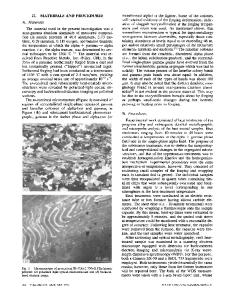Coating of SIC on Titanium Aluminide
- PDF / 2,129,288 Bytes
- 6 Pages / 420.48 x 639 pts Page_size
- 13 Downloads / 365 Views
COATING OF SIC ON TITANIUM ALUMINIDE
SHYI-KAAN WU AND RAY Y. LIN Institute of Materials Engineering, National Taiwan University, Taipei, Taiwan 106, ROC Department of Materials Science and Engineering. M.L. #12, University of Cincinnati, Cincinnati. Ohio 45221-0012, USA ABSTRACT Coating of silicon carbide on the surface of structural materials is being used in industry to improve the oxidation resistance and wear resistance properties. In this study, silicon carbide coatings were applied on titanium aluminide by both chemical vapor deposition and sputter deposition techniques. Chemical vapor deposition of SiC was accomplished by reacting methyl trichlorosilane (MTS) and hydrogen in the presence of argon on the substrate surface at 1100 C under 1 atm pressure. Sputter deposition of SiC was completed in a Cooke sputter deposition system using a SiC target at 10 mTorr argon total pressure and 100 watt power. Under the experimental conditions of this study, the deposition rate of CVD SiC is about 10 im per hour whereas that of sputtered SiC is about 1 pim per hour. To minimize the thermal residual stress between the aluminide substrate and SiC coating as a result of the coefficient of thermal expansion mismatch and temperature variation, a thin layer of TiC was coated prior to the SiC coating. For sputter deposited SiC, it was found that when the coating was done at room temperature, the adhesion of coating to the aluminide substrate was poor. The coating layer spalled off when the coated specimen was thermal cycled to 900 C. By coating the carbides at an elevated temperature, e.g. 560 C. strong adhesion between carbide coating and the substrate was obtained. The coating survived many thermal cyclings. The degree of surface roughness ranging from #80 to #800 grit surface polish did not affect the adhesion of coating. 1. INTRODUCTION Titanium aluminides is a new class of material receiving significant attention lately for structural applications at elevated temperatures[1] especially in the aerospace industry. This is primarily due to the high temperature strength retention of this class materials. However, it has been reported that the oxidation resistance of the two commonly used titanium aluminides, i.e. Ti 3 AI and TiAI, is far from being acceptable for use in air at the anticipated application temperature, namely, up to 1000 C.[2,3] To increase the oxidation resistance of titanium aluminides, alloying elements which may form protective oxides have been added in aluminides. Niobium addition is one of the examples in the anticipation of forming niobium oxides or other complex oxides. The other approach of improving the oxidation resistance of aluminides is the application of oxidation resisting coatings. Silicon carbide, with its excellent oxidation resisting property, has the potential of being used as a protective coating for titanium aluminides. The objective of the present study is to investigate silicon carbide coatings on TiAI applying the chemical vapor deposition and the sputter deposition techniques. 2. EXP
Data Loading...











